What to do if advertising windows pop up. How to get rid of advertising on the Internet: ways to solve the problem.
I would like to start the conversation about advertising with a modified phrase of the classic Belinsky: "Do you DO NOT love advertising, as I DO NOT love it, with all the forces of your soul?" Indeed, it is difficult to imagine a person who would be happy or neutral about the dominance of “tempting offers” on his computer screen. However, no one asks our opinion on this issue: if you manage to pick up an advertising "virus", if you please "enjoy".
No, we will not enjoy the ugliness. Today I will tell you how to remove ads in browsers when no antivirus helps, and how to prevent its reoccurrence.
Where do the "ears" of the problem grow from?
If you remember, a couple of years ago, ad virus infections were not as frequent as they are today. And the reason is as follows:
- Promotion of goods and services through the media no longer gives the return that advertisers need. People have adapted to skipping ads "out of sight and ears." Or turn it off.
- Rapid growth of the Internet audience. Former TV viewers today prefer to find out the news, watch films and programs not on TV, but through the network.
- Strengthening legal requirements for advertising materials that are distributed through the media and other controlled sources. And on the Internet, as you know, there is no censorship.
- The widespread use of ad blockers - the so-called "ad cutters" such as AdBlock.
All this, and especially the latter, contributes to the fact that advertising in browsers becomes larger, more intrusive and more aggressive. Whole developer companies are working on its creation. Their task is not only to make the viewer necessarily see the banner (video, ad, etc.), but also to make it as difficult as possible to stop showing. Ideally impossible.
As advertisers are willing to invest in this, the problem will get worse in the coming years. And we have to learn to resist it.
Why Antiviruses Don't Help
The task of antiviruses is to protect the computer from programs that can cause obvious harm to the system or the user - to steal, damage information, etc. Adware - adware, in fact, does nothing of the kind - it only collects information about the user's interests and shows him banners. And this is not prohibited by law. In addition, there are many free apps and websites. If antiviruses started to "chop" them, they simply would not exist.
However, Advari developers sometimes overstep the boundaries of what is permissible - they endow their products with the ability to disguise and prevent deletion. And sometimes - to collect obviously unnecessary information about the user. Such software is no longer adware in its purest form, antivirus vendors classify it as spyware (spyware) or Trojans. And they add them to the virus databases.
And how do you deal with it?
What does a user do when he sees an advertisement in the browser that does not clearly belong to a specific site, but appears on its own? Launches antivirus. And he finds nothing. Downloads another - and history repeats itself. Why this happens, I hope, is understandable.
Since "adware" and other potentially unwanted software uses different ways installation in the system, it is optimal to proceed according to the instructions that I will give below.
Remove unnecessary browser extensions and change the start page
Installing web browsers in the form of extensions and applications is a favorite way to populate the "adwari" into the system. But also the easiest to remove.
Let's go through the menu of the infected web browser to the extensions section.
And we will delete everything that appeared there without our knowledge.

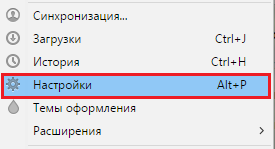
and check if the quality is not set start page some kind of "left" site. If yes, delete the entry.
Next, let's restart it and check if the problem is resolved. If not, let's move on.
Removing the malware through Programs and Features
Adware created by honest developers installs on the system like regular applications. And just like them, it is removed through " Programs and Features". Let's open it and see if something has appeared there without our participation. If it does, delete it.

After that, we restart the computer and check again if the problem is solved.
Cleaning up web browser shortcuts
The third favorite place of registration of adware programs is a shortcut on the desktop with which the user launches a web browser. To clear it of unnecessary entries, do the following:
- Let's open context menu problem shortcut and select properties.
- In the properties window go to the tab “ Label"And see what is indicated in the" An object". Normally, there should be a path to executable file browser and nothing else. For example, C: \ Program Files (x86) \ Google \ Chrome \ Application \ chrome.exe. A postscript in the form " http: // site"Or replacing the executable file with something else, like" chrome.lnk», « chrome.bat», « googlechrome.exe"And so on - this is the source of the problem. If you see something like this, correct the entry.

If changing the settings of the shortcut is blocked (this is done to protect the malware from deletion), try the following:
- Remove the shortcut from the desktop to the trash can and create a new one. To do this, open the folder with the application, click right click mouse over the executable file and select " Create shortcut". Place it on your desktop instead of the old one.

- If the shortcut is not removed (you do not have permission to do so), open the tab “ Security”And designate yourself as owner. To do this, click the " Additionally"And in the next window next to the owner's name, click" Change».
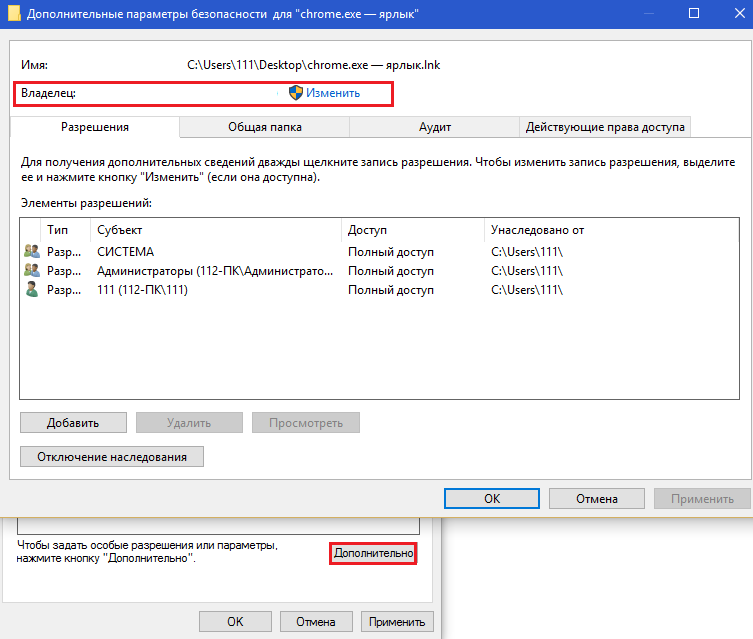
Enter in the field “ Selectable object names"Yourself, click" Check names"And OK.
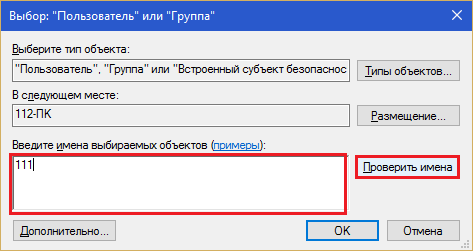
In the window " Extra options»Also click OK. After that, the functions of cleaning and deleting will become available to you.
After manipulating the label, eliminate everything malicious files that were spelled out in it.
Reinstalling the browser
Reinstallation will be a radical solution when banners are displayed in only one of the web browsers. The reason may be malicious script, buried in the depths of the program, or patching files (adding a virus code to the "body" of the file, for example, one of the dynamic libraries of the browser).
In order not to lose your bookmarks, settings and history, sync them in browsers on different devices.

Or import from an infected web browser to a clean one.
![]()
If advertising is displayed on all devices connected to the same network
In this case, another infection mechanism is implemented - reconfiguring the network parameters of a PC or router. More precisely, changing the provider's DNS server - the node that matches domain names sites to their IP addresses. After changing DNS, instead of the requested site, another or the same one opens, but with an advertising makeweight.
The DNS spoofing operation is performed by a Trojan horse of the DNSChanger class. After doing the dark deed, she is removed from the computer. Here's another reason why antiviruses do not help - the setting remains, but the culprit is no longer there.
To check if this is your case, go to the folder network connections... In Windows 8-10 it is convenient to do this through the context menu "Start", in Windows 7 - through the "Network and Sharing Center". Open the properties of the network you are connected to. On the tab “ Network"In the list of components, click" IP version 4"And the button" Properties».

The DNS addresses are listed in the bottom half of the next window. If they do not belong to your provider and are not public (like mine), you need to fix them. As you guessed it - on the provider or public.

If you use a router, you need to do the same procedure on it. Find out where the required parameter is from the instructions.

Adware removal programs
There are special tools for extermination of advertising evil spirits - AntiAdware applications. They remove from the system not only the files of the malware, but also its autorun keys from the registry, task scheduler and other places.
The search for adware modules and their traces is carried out on the basis of "virus" databases and heuristic analysis, with the help of which the program determines the harmfulness of the scanned objects. The heuristic check allows you to find unknown threats (as opposed to databases that detect only known ones), but it gives a noticeably high percentage of errors, so you cannot completely rely on it. Otherwise, completely harmless and even required files operating system and programs.
Attention! Before starting any of the described applications,. It will help restore the system to work if an important object is deleted by mistake.
AdwCleaner
Cleans adware and spyware files, their services, folders, browser add-ons (panels and extensions), shortcuts, registry entries and scheduled tasks from the computer. It works on the basis of bases, which makes it relatively safe in terms of false positives. But it never hurts to double-check what you are going to remove.
After running AdwCleaner with administrator rights, click “ Scan". The check will take several minutes, after which the result will be displayed on the tabs of the main window.
All found objects will be marked with flags. If you want to keep something, uncheck it. To start the cleaning process, click the button of the same name. When finished, restart your computer.
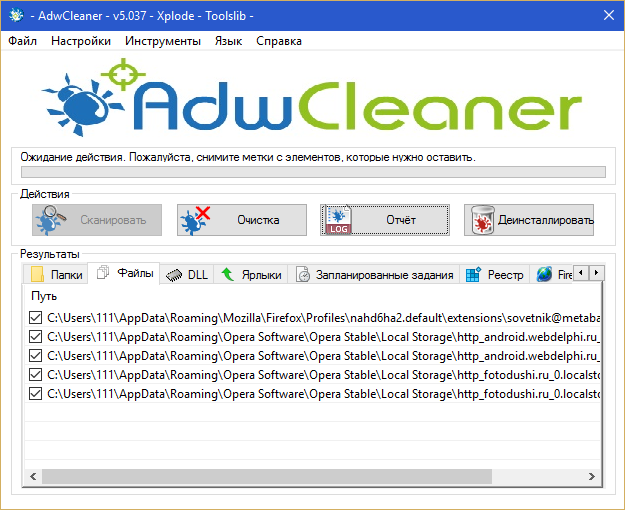
Malwarebytes Anti-Malware
- a powerful program to combat viruses, Trojans, rootkits, spyware and potentially unwanted software, as well as their traces in the system. It has a paranoid heuristic, so the percentage of false positives is quite high. It's not safe to delete everything found! Be sure to check through search engines that represents every suspicious file and every registry entry.
For a one-time treatment, Malwarebytes Anti-Malware is free to use. For permanent protection - only for a fee.
V demon paid version there are 2 check modes - selective and full. To remove adware, it is enough to scan startup objects and memory.

After scanning, the window will display a list of potential threats. Remove the marks near those you want to leave, eliminate the rest.
Junkware Removal Tool
Junkware Removal Tool Is another Malwarebytes product designed for the most common unwanted software. Before deleting threats, it does not display any prompts to the user, it works automatically. Creates a backup of the registry prior to cleaning.
In terms of false detections Junkware Removal Tool relatively safe as it only uses bases.
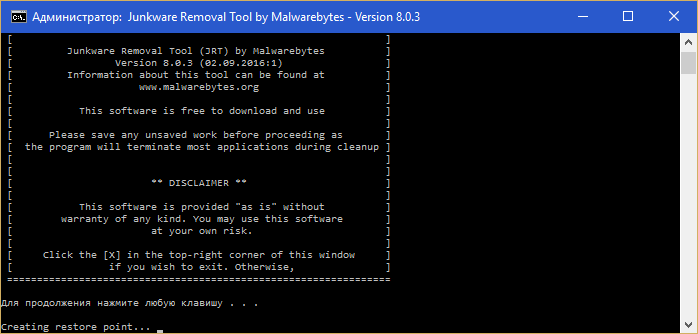
How to reduce the risk of infection with adware "viruses"
- Always take a close look at what you install along with the applications. By doing this without looking, you agree to the installation of add-ons, which, among other things, will "please" you with "tempting offers."
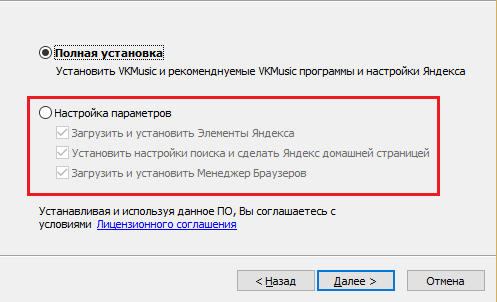
- Do not give up using antiviruses - they cope with a particularly harmful "adware" with a bang.
- Install software only from trusted sources. Optimally - from the official sites. Any application, even the most harmless one, can be glued with a "gift".
- Do not use the default username and password to log into the router's web panel. Because they are used by Trojans of the DNSChanger class.
- Create backups bookmarks of web browsers. Optimal - sync them across multiple devices. There is malware that deletes the user's bookmarks and saves pages with ads instead.
And take care of yourself and your information!
Bad advertising
Nevertheless, many sites use other advertising services, which can be not only useless for users, but also very harmful, as it translates to sites of questionable content.
Some advertising also translates to sites with paid content, and the user may not even know about it, but from his mobile communications after that, they begin to withdraw 10-20 rubles daily.
Well, advertising from some sites can lead directly to sites containing various viruses.
So, in any case, especially novice users just need to protect themselves from at least harmful advertising on the Internet. Here we are not talking about protection from harmful sites in general, but only from advertising, which may even be present on some useful sites.
How to remove annoying ads
In order to remove ads when using the Internet, there are several suitable options. Some of the most popular on the web are free browser add-ons such as Adblock, Adblock plus and Adguard ad blocker which we'll cover in this article.
Let's start with the addition Adblock which unfortunately as far as major browsers is concerned only works with Google chrome(Chromium).
How to install and use Adblock
Through your browser Chrome go to this add-on at the following link >>>.
Click on the button IS FREE:

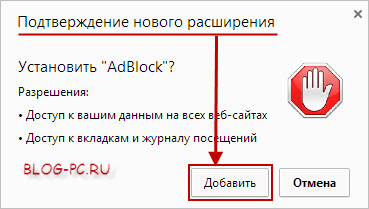
Adblock will be installed, it remains only to activate it by clicking on the icon, as shown in the picture:

But, if you need to exclude some site or site page from the Adblock check, then click on the Adblock icon (in the upper right of the browser) with the left mouse button and select the desired function in the menu that appears:
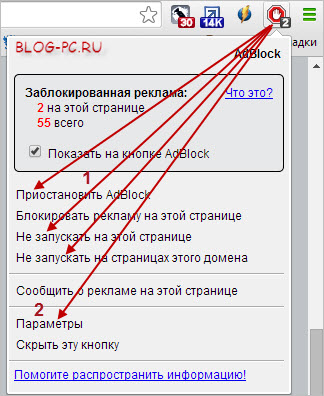
After that, you need to refresh the page of the required site by clicking on the refresh icon or on function key keyboards F5.
Let's move on to the next extension.
How to install and use Adblock Plus
If you have a different browser (not Google Chrome), in this case, you can use another extension to block ads Adblock plus... This extension contains more settings and is suitable for use in all major browsers such as Google Chrome, Mozilla, Opera, and also for smartphones and tablets on the Android platform.
To install Adblock Plus, go through your browser, where you need to install this extension, or through a smartphone or tablet to the Adblockplus website. The system will automatically determine which browser we have and will give you the opportunity to download and install this extension:
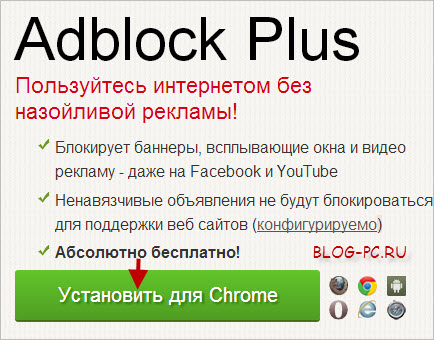

Adblock plus1 ).
In addition, if necessary, you can manually additionally block some element on the site that we do not want to see ( 2 ):
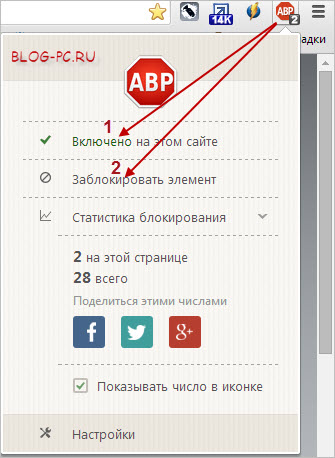
And there is the third popular ad blocking extension.
How to install and use Adguard Anti-Banner
At the time of this writing, this extension is only available for the Chrome and Opera browsers.
To install this add-on in the Google Chrome browser >> "> follow this link >>>
To install this add-on in the Opera browser >> "> follow this link >>>
Click on the button IS FREE:
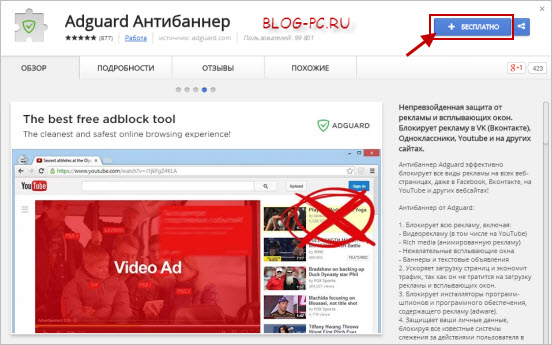

After that, an extension button will appear in the upper right corner Adguard ad blocker, by left-clicking on which you can, if necessary, Turn off ad blocking on a specific site ( 1 ).
And also, if necessary, you can manually additionally block some element on the site that we do not want to see ( 2 ):

Which extension to use
Each of these ad blocking extensions are good. You can try each of them to determine exactly for yourself which one is preferable to you. The only thing is that when you test the work of these add-ons, there is no need for all of them to be enabled at the same time.
The fact is that since the loaded information passes through the filters of these add-ons, it means that they take some time to load the pages. When one of these extensions is enabled, it is not particularly noticeable, but when all are working, then this is already superfluous.
Therefore, to disable / enable this or that extension in the browser, you can go to Settings— > Instruments-> Extensions:

And use the checkboxes to enable or disable this or that extension:
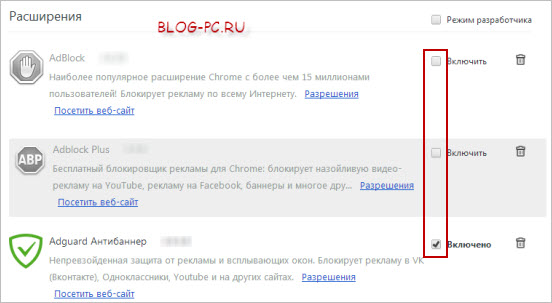
A program to block ads in ALL browsers
If you like the latest Adguard Anti-Banner extension, you can install a program from the developers of this extension, which allows you to block ads in all browsers installed on your computer.
In addition, the Adguard program provides additional protection against malicious sites and Internet fraud, and also contains built-in protection against porn sites.
This program is paid (100-600 rubles depending on the type of license and the term of use). But the developers also provided for its free use instead of 4 recommendations of this program to their friends.
We considered this use of recommendations for the paid version of the Avast antivirus Internet Security, which I already wrote about on a separate page.
Adguard can also be used for free for 14 days. This is quite enough to understand whether it is worth purchasing it or it will be enough to use free browser extensions.

If the issue of ad blocking is relevant for you, then I recommend that you take some time to test all three free extensions described in the article, and also decide for yourself what to use next.
Greetings friends. Today's conversation will focus on how to disable ads in Yandex Browser using the built-in tools of the browser itself and using third-party, time-tested add-ons. Almost every one of us, who works on the Internet or just spends his time there, every time comes across such an abundance of advertising that it becomes increasingly difficult to get the information you really need. I decided to show you 2 surefire ways to get rid of ads, by applying which, your Internet browsing will become more convenient and safe.
So let's get started.
Ways to disable ads in Yandex Browser
Adguard add-on
Launch Yandex Browser and click the button with three horizontal stripes in the upper right corner, then select the Add-ons item.

Go down in the window that appears, to the Security block and move the switch in the Adguard line to the right side (the inscription On will appear. Highlighted in yellow).
The browser may ask you to confirm the activation of the add-on, for this you need to click on the window that appears in the upper right corner of the window.
Everything, the add-on is activated and working. Let's see, on the example of my blog, how it all looks.
Open any page of my resource and click on the green shield in the upper right corner.

You will see information with the number of blocked ads, and in this window you can also mark an ad unit that has not been marked with an add-on - the Block ads on the site and customize Adguard item to suit your needs - the Configure Adguard item (whitelist of sites, anti-phishing and other useful functions) ... The question of how to disable ads in Yandex Browser for free is 100% resolved.
Adblock Plus extension
Another useful add-on that can be used to disable ads in Yandex Browser is called Adblock Plus. Let's move on link, and in the upper left corner in the search bar, enter adblock plus, press Enter.

Note! We use an extension from the Chrome web store, since almost all extensions from it are suitable for Yandex Browser.
From the list that appears, select the Adblock Plus extension and click the FREE button.
The extension will ask for your consent to install, confirm this action and after a few seconds, you should see a window like this confirming the successful installation of this add-on.

The principles described in this article will work for any browser., but in order to understand how to remove ads in the browser - if there is a virus on your computer or laptop and how to get rid of ads in the browser - if you do not want to see contextual ads, then for this you need to read the entire article. Because some users need, for example, to remove Google and Yandex ads, while others have a different situation - they show banners that are not actually on the site. But first things first.
In this article, we will discuss with you not only how to remove pop-ups in the browser, but also find out the reason why this happened. But the first thing you need to do now is check your computer for viruses. This must be done for your own safety. After all, if there is 1 virus on your computer, then it is possible that somewhere in the wilds of the operating system files, several more viruses are hidden that do not show their activity, or you simply will not notice their actions on your computer or laptop. How to check the device under Windows control you can read in the article: "".
Check properties of browser shortcut and exe file
Consider the case where an ad appears immediately after launching a browser. Most often, this type of advertising begins to annoy us due to the penetration of a virus into our system. What exactly does this virus do? All programs in the operating room Windows system run through a special file with the *. exe... and it does not matter at all whether this program is - a small utility or a large professional application such as Microsoft Office.
The shortcut that we click to launch the program refers exactly to exe file programs. Now let's think about it: if, when launching a browser shortcut, instead of the start page, a page with an advertisement opens, then perhaps this very shortcut refers not to the exe file we need, but to the page with the advertisement. Let's check it out.
Click on the browser shortcut with the right mouse button and select "Properties". If there are no shortcuts on the desktop to launch the browser (maybe there is one, but only on the taskbar), then in this case go to C: \ Program Files and find the folder that will be named as your browser, for example, C: \ Program Files \ Google \ Chrome.
In the "Shortcut" tab, find the line "Object". In the field opposite it, in quotes, the address of the file to which this shortcut refers is indicated. Pay attention to the name and extension of the file. This is what the executable files of the most popular browsers are called:
Opera - launcher.exe;
Internet Explorer- iexplore.exe;
Google Chrome - chrome.exe;
Mozilla Firefox- firefox.exe;
Yandex - browser.exe.
Here's an example Google browser Chrome:
In addition to the file name itself, you must make sure that the shortcut refers to the exe file. It so happens that next to the executable file of the browser, for example "launcher.exe", there is a file with the same name, but with a different extension, for example "launcher.url". It is these files that are created by viruses, and they can be referenced by your shortcuts. If this is indeed the case, then delete such a file, then go back to the properties of the shortcut and write the correct address to which this shortcut should refer.
This is how your shortcut properties might look like (replace url with exe and remove url from the folder where the shortcut refers):
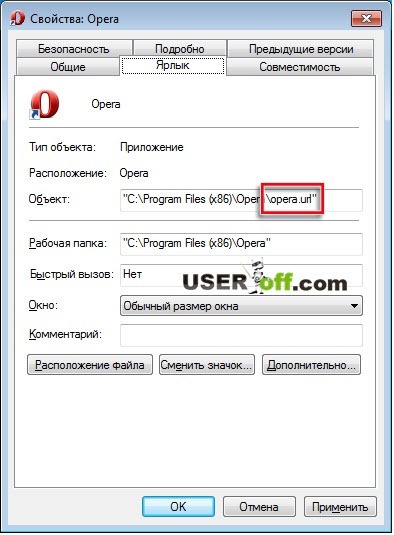
If you have several Internet browsers installed on your computer, then the procedure for deleting the "double" file must be repeated with each browser. By default, browsers are installed in the " C: \ Program Files"(If you have a 32-bit version of the operating system installed) or to the directory" C: \ Program Files (x86)"(If you have a 64-bit version of the operating system).
If you cannot find the folder where your browser is installed, then right-click on the browser shortcut and select "Properties". In the window that opens, click the "File Location" button. A folder will open where the executable file of the Internet browser is located.

This is the main way how to remove banners in the browser, but if it didn't help you, then let's find out the reason further.
Disable / remove extensions that display ads
Advertising can haunt not only when you launch your browser, but also in the process of surfing the Internet. Imagine that you go to a completely familiar site that you often visit, but instead of it, other information opens in the form of a banner, which takes up most of the workplace in the browser. You try to visit the site again and again the same picture. Or you still went to the site, but some kind of banner constantly appears in the middle of the screen, or advertising banners appear along the edges of the site, which not only interfere with their appearance, but sometimes are accompanied by various sounds.

Now you need to look at the list of installed add-ons / extensions in the browser. Sometimes some of these extensions appear in browsers not on your initiative, and it is they who control the appearance of incomprehensible banners and links. How do I get rid of this kind of add-ons?
- In Google Chrome, click the menu button, find the "Tools" item in the list, and then the "Extensions" item;
- In Yandex, press the menu button and select "Add-ons" from the list;
- In Opera, after pressing the menu button, select "Extensions";
- In Internet Explorer, click the gear button, and then find the "Add-ons" item;
- In Mozilla Firefox, go to "Add-ons", and then in the tab that opens, select "Extensions".
After you have navigated to the list of installed extensions, carefully examine the list for any extensions you are not familiar with. If there are any, then disable them or, best of all, delete them. If advertising on sites disappeared, then you correctly detected malicious extensions and can safely remove them. If you cannot find this extension / plugin, then try disabling everything. Thus, you will understand if there is an extension that shows banners in your browser.
For example, there is a Better Surf Plus plugin on the Internet that needs to be removed from the extensions.
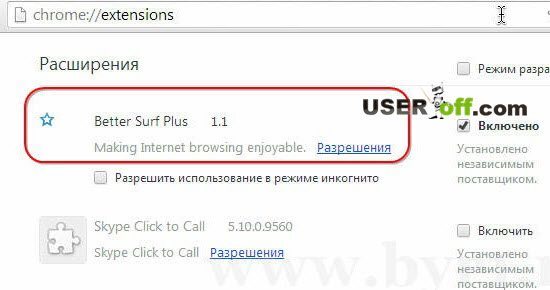
If you found a plugin that showed ads in your browser, then you should also check installed programs with the same name. To do this, go to the "Control Panel" via "Start" and select "Programs and Features". Then go through the entire list carefully. If you find the name of the program with the name of the plugin that you just uninstalled or disabled, then uninstall that program.
The danger of such extensions is that they are not viruses in themselves, which means they will not be detected. antivirus program... But on the other hand, they can contribute to the penetration of viruses into your computer through various malicious links from banners. For those who were looking for specific information, for example, how to disable ads in the Yandex browser, I think it is now clear that it makes no difference which browser is installed on your computer. The main thing is to know the reason - why the banners appear in your browser.
Adguard program
And how to remove ads in the browser if it is legally present on the site? The developers of the Adguard program took care of this. This program can be downloaded for free from the official website of the developer for 14 days. During this time, you can evaluate it and decide whether you need it or not. By the way, this program we played with this company on my blog, I can say that they are not only good developers and marketers, but also wonderful people.
Some of the features of this program are:
- Removes all possible types of advertising;
- Defines the content of the pages and blocks it for children to visit;
- Warns the user if he went to a site with a low reputation;
- They remove ads even before downloading them to the computer, Adguard speeds up page loading and reduces the consumption of Internet traffic.
As you can see, this program has a lot of useful features. However, it works great with any internet browsers.
Here is the official video of the program:
Leave all the default settings during the installation. Here are the installation steps:
- Click "I accept the terms";
- "Further";
- "Further";
- "Ready"
The program will open, select the desired language and click "Continue". Next, select filtering and click "Finish".
Note: to open the program, you must double-click the left mouse button in the tray on the corresponding icon. In the list on the left, we see several items.

First, let's look at the item "Protection". In this section, you can disable or enable the program by pressing the "Protection is enabled and running" button ("Protection is completely disabled"). Below this button there are three tabs: Anti-Banner, Anti-Phishing, and Parental Control. In them, we can enable or disable these functions. Let's see what these functions mean. Anti-Banner blocks ads that pop-up on the site, Anti-Phishing prevents potentially dangerous requests, Parental Control ensures that adult sites are inaccessible (disabled by default).
Please pay attention to how many objects were scanned in 2 hours on my laptop:
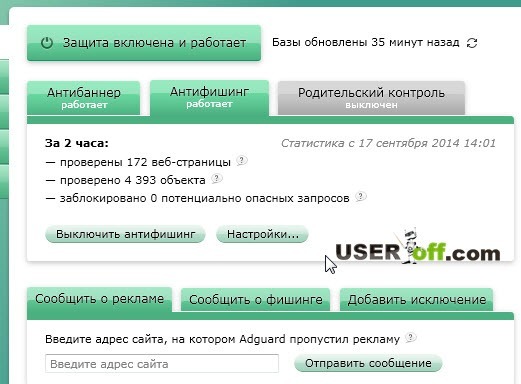
The "Settings" item allows us to: select the program language, launch the program automatically when the operating system boots, and enable automatic update programs. Filtering settings include: enable / disable Adguard assistant (located in the lower right corner of the browser), enable / disable site reputation warning (help you avoid visiting sites with low reputation), configure the auto-connect function of the most suitable filters and enable / disable the display function useful advertising (such is the contextual advertising of search Google services, Yandex, Mail, etc.).
In the "Support" section, you can enter your address Email and the subject of the message, contact the program support service for questions or problems of interest and incomprehensible to you.
As you can see modern methods advertisements for goods and services are not always fair and are increasingly intrusive. But now you know how to remove ads in the browser. It turned out to be quite simple. The work takes 5-10 minutes, but then you can comfortably and safely communicate in social networks and travel the world wide web.
There are many more ways to remove banners in your browser! I will not be able to post all this information in one article, so visit my blog and you will learn a lot more interesting things!
If the information helped you, or if you know other ways to combat advertising, you can leave your comment below.
Pop-up ads are one of the most annoying ways to notify a consumer about a product or other service. For comfortable work on the Internet, many people prefer to disable pop-up windows in the Yandex browser, using different methods for this. The reason often lies not so much in the fact that users are annoyed to periodically view advertisements, but in the fact that fraudsters have begun to use the demonstration of pop-up windows in order to spread viruses and malware.
Another type of pop-up advertising is displaying ads, banners and images on all sites in a row and even in different browsers... Pop-ups can appear as soon as you click anywhere on the site. As a rule, such ads have dubious content, and also very nerve-racking. How to remove pop-up windows in the Yandex browser will be described in this article.
The easiest way to get rid of pop-ups if they open up from time to time when visiting certain sites. By itself, pop-up blocking in Yandex browser can be disabled in the settings. This parameter is adjusted in the Yandex Browser settings menu, and here's how to disable pop-up windows:
Open " Menu"And select" Settings»:
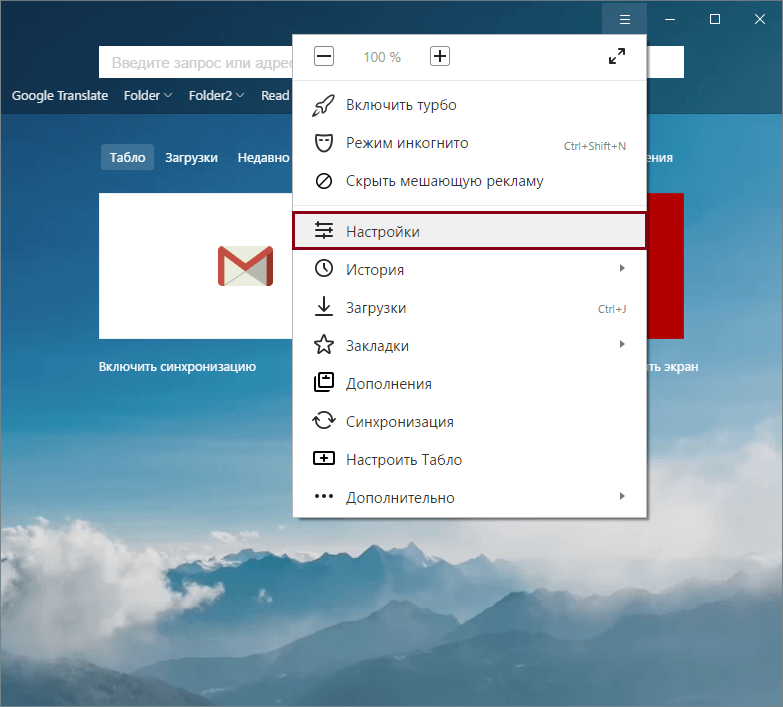
At the bottom of the page, select " Show advanced settings»:
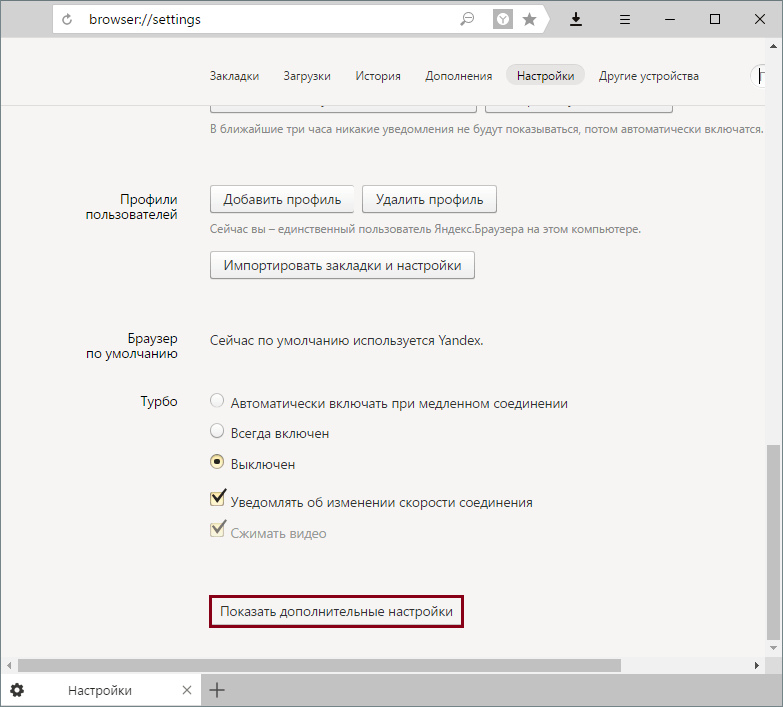
In the block " Personal data protection" Press " Content settings»:

In the window that opens, find the block “ Popup windows"And select the option" Block on all sites».

Installing ad blockers
Often, the previous method does not protect against pop-up ads, since they have already learned to bypass it. In this case, installing various blocker extensions helps. There are many different extensions for Yandex Browser, and we recommend the most popular and proven ones:
Above we have listed several best extensions and added links to overview and installation articles to them.
Installing programs to remove malware
Advertising that appears in different browsers and opens, one has only to click on any button on the site, usually caused by poor quality software installed on your PC. These can be both accidentally installed programs of the nature of AdWare (adware), and various browser extensions. In order not to look for the cause yourself, we advise you to turn to utilities that will do it yourself:
What if the problem persists?
Perhaps, malware changed parameters local network, which causes the PC to connect to a specific server and display ads. Typically, in this case, the user receives a proxy connection error message. You can solve it as follows:
Open " Control Panel", Switch the view to" Badges"And select" "(or" Internet options»):

In the window that opens, switch the tab to " Connection"And select" ":

In this window, remove the registered parameters and switch to " Automatic detection parameters»:
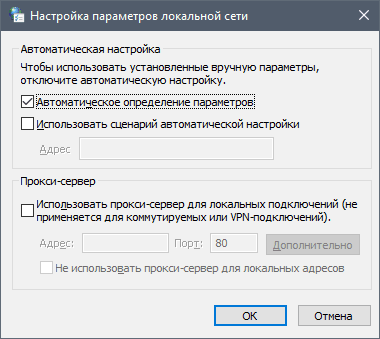
Usually, these steps are enough to get rid of ads in Yandex Browser and other browsers. To prevent this from happening in the future, be careful about what you download to your PC, be careful when installing programs, as additional software is often installed during the installation process. Keep an eye on the extensions installed in the browser.
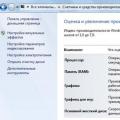 Processor Testing Program
Processor Testing Program Free Windows Software Free Download Latest Wine 10 Updates
Free Windows Software Free Download Latest Wine 10 Updates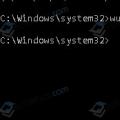 Free Windows software download for free Update Windows 10 to a new one
Free Windows software download for free Update Windows 10 to a new one